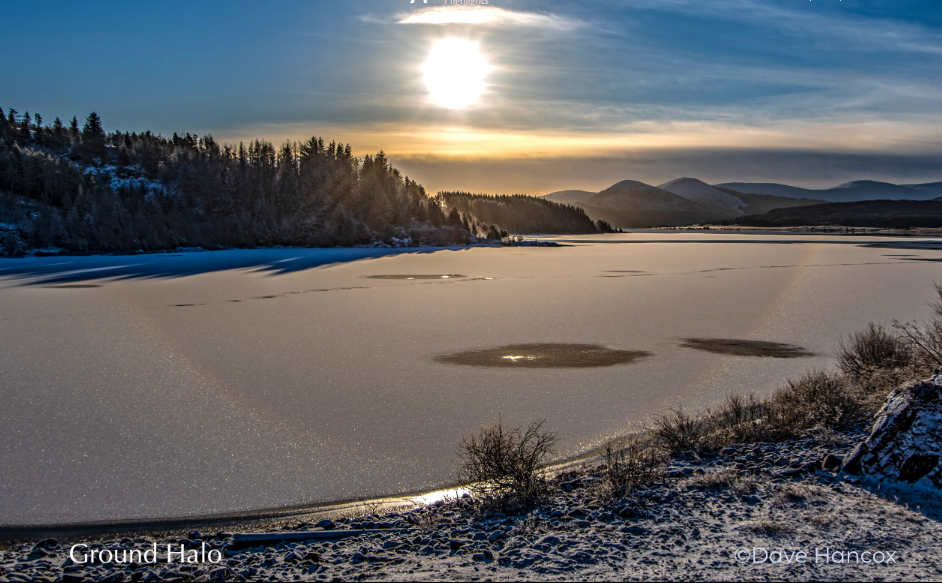Ground halo, Loch Doon, Scotland - Atoptics Highlights OPOD
Ground Halo, Loch Doon, Scotland - Atoptics Highlights OPOD
The mesmerizing phenomenon of ground halos never fails to captivate our attention. Recently, a stunning 22 halo was captured on the ice of Loch Doon in Scotland by Dave Hancox. This breathtaking image, taken after a night that dipped to -8 Celsius with a light dusting of snow, showcases the beauty and intricacy of this atmospheric optics phenomenon.
Ground halos, much like their celestial counterparts, rely on optically high-quality hexagonal prism crystals. These crystals, which are responsible for creating the halo, grow slowly overnight. Interestingly, snowflakes alone cannot fulfill this role. Instead, the sublimation of snowflakes and the evaporation of water from the loch supply the necessary water vapor. The resulting fairly large column crystals, resting at various angles, come together to form the remarkable 22 halo.
When observing a ground halo, it becomes evident that crystals located anywhere near the cone's surface reflect light into our eyes, resulting in the formation of the 22 halo. The interaction between light and these glinting crystals creates a stunning visual display that leaves us in awe of nature's artistry.
To the untrained eye or a camera lens, the ground halo appears as a perfect circle. Regardless of the distance at which the glinting crystals are located, halos maintain the same size and shape. However, when we consider the actual path of these glinting crystals on the ground, a fascinating phenomenon is revealed. The path takes the form of a hyperbola, intersecting with the cone of halo rays to create an optical illusion. While our eyes perceive a circular halo, our brain interprets it differently when combined with distance cues from the surrounding landscape.
As we marvel at the ground halo's enchanting beauty, it is important to note that its colors are not limited to the inner edge. While the inner edge showcases a vibrant red hue, we can also observe reds in the outer regions. These additional colors are a result of sunlight passing through crystals oriented in a way that deviates from the minimum deviation angle. This variation in crystal orientation adds further complexity and visual intrigue to the ground halo phenomenon.
In conclusion, the ground halo witnessed at Loch Doon, Scotland, is a testament to the wonders of atmospheric optics. The intricate formation of optically high-quality hexagonal prism crystals, combined with the interplay of light and the surrounding landscape, results in a breathtaking display of nature's artistry. As we continue to explore and study atmospheric phenomena, we uncover the hidden beauty and complexity that exists above and around us. The ground halo serves as a reminder of the enchanting mysteries waiting to be discovered within our atmosphere.

A 22 halo on the ice of Loch Doon, Scotland. A morning capture by Dave Hancox after a night dipping to -8 Celsius with some light snow.

Ground halos rely on optically good quality hexagonal prism crystals just like those in the sky. Snowflakes will not do. The required crystals grow very slowly overnight. Sublimation of snowflakes and evaporation of the loch water supply some of the water vapour needed. Failry large column crystls resting at all angles make the 22 halos.
Crystals anywhere near the cone surface glint light into the eye to form a 22 halo

The halo cone intersecting the ground forms a hyperbola. to the eye it remains a circle but distance and landscale cues tell the brain otherwise.
To the unbaised eye or camera the halo is a circle. Halos have the same size and shape regardless of the distance of the glinting crystals making them.
However, the actual path of the glinting crystals on the ground is a hyperbola. It forms at the intersection of the cone of halo rays to the eye and the horizontal ground plane. The path seen by the eye remains circular but combine it with the landscape distance cues and the brain can think differently.
Some of the individual crystal glints. we see the halo's red inner edge.
Yet there are reds in the outer regions too. These come from sunlight passing through some srystals oriented so that the rays are not at minimum deviation.
Note: this article has been automatically converted from the old site and may not appear as intended. You can find the original article here.
Reference Atmospheric Optics
If you use any of the definitions, information, or data presented on Atmospheric Optics, please copy the link or reference below to properly credit us as the reference source. Thank you!
-
<a href="https://atoptics.co.uk/blog/ground-halo-loch-doon-scotland-atoptics-highlights-opod/">Ground halo, Loch Doon, Scotland - Atoptics Highlights OPOD</a>
-
"Ground halo, Loch Doon, Scotland - Atoptics Highlights OPOD". Atmospheric Optics. Accessed on November 15, 2024. https://atoptics.co.uk/blog/ground-halo-loch-doon-scotland-atoptics-highlights-opod/.
-
"Ground halo, Loch Doon, Scotland - Atoptics Highlights OPOD". Atmospheric Optics, https://atoptics.co.uk/blog/ground-halo-loch-doon-scotland-atoptics-highlights-opod/. Accessed 15 November, 2024
-
Ground halo, Loch Doon, Scotland - Atoptics Highlights OPOD. Atmospheric Optics. Retrieved from https://atoptics.co.uk/blog/ground-halo-loch-doon-scotland-atoptics-highlights-opod/.